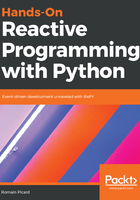
The timer operator
The timer operator creates an observable that emits an item after an absolute or relative time has elapsed. After this first emission, the observable emits items periodically if a period value has been provided. The following figure shows the marble diagram of the timer operator without a period:

The following figure shows the marble diagram of the timer operator with a period:

The prototype of this operator is as follows:
Observable.timer(duetime, period=None, scheduler=None)
The duetime parameter can be an absolute or relative value. Absolute values are provided as timedate objects. Relative values are provided as integers in units of milliseconds.
The period parameter is optional. When it is omitted, the observable emits a single item, the 0 number, and completes. Otherwise, the observable emits increasing numbers at the period provided. The period parameter is an integer that represents milliseconds.
The following is an example of a single shot timer observable:
import datetime
print("starting at {}".format(datetime.datetime.now()))
one_shot = Observable.timer(1000)
one_shot.subscribe(
on_next=lambda i: print("tick {} at {}".format(
i, datetime.datetime.now())),
on_error=lambda e: print("error: {}".format(e)),
on_completed=lambda: print("completed")
)
The preceding code will provide the following results:
As expected, the item was received one second after the program started. The following example (with a period) never ends unless it is interrupted:
import datetime
print("starting at {}".format(datetime.datetime.now()))
tick = Observable.timer(1000, period=500)
tick.subscribe(
on_next=lambda i: print("tick {} at {}".format(
i, datetime.datetime.now())),
on_error=lambda e: print("error: {}".format(e)),
on_completed=lambda: print("completed")
)
The output is as follows:
The first item is received after one second, but the other ones are received every 500 milliseconds. Note that the value of the item increases at each emission.